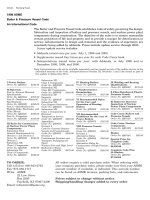Process Engineering Equipment Handbook Episode 3 Part 3 potx
Bạn đang xem bản rút gọn của tài liệu. Xem và tải ngay bản đầy đủ của tài liệu tại đây (1.03 MB, 50 trang )
Pulp and Paper P-213
FIG. P-224 Steam production for different scenarios. (Source: Ahlroth and Svedberg.)
FIG. P-223 Power output for different scenarios. (Source: Ahlroth and Svedberg.)
TABLE
P-25 Simulation Results for the Hybrid System and the Tomlinson Boiler
Power Output Thermal Efficiency
Power Production (MW) (%)
Gas turbine Steam turbine
Reference case 11.8 13.8 33.1
Low heat demand case 11.8 17.8 38.2
Biomass gasifier malfunction 2.1 7.0
Black liquor gasifier malfunction 13.5 8.1 45.6
Tomlinson boiler 35.6
Steam Production Saturated Steam Produced in t/h
Pressure in bar 3 5 12
Reference case 3.4 28.3 10.5
Low heat demand case 1.6 3.9
Biomass gasifier malfunction 1.6 16.4 10.5
Black liquor gasifier malfunction 1.4
Tomlinson boiler 24.6 206.7 76.5
Steam demand 28 235 87
Production Minus Demand (t/h) “+” is surplus and “-” is deficit
Reference case Balance Balance Balance
Low heat demand case +1.6 +3.9 Balance
Biomass gasifier malfunction -1.8 -11.9 Balance
Black liquor gasifier malfunction Balance
1
+1.4 Balance
1
1. Steam demand is lower in this case.
P-214 Pulsation Dampeners
It is therefore noticeable that in all studied cases with a hybrid energy system
instead of a conventional one, the process steam demand for the pulp mill is
satisfied at all points of operation, except when the biomass gasifier suffers a
malfunction. The introduction of the hybrid-energy system, with black liquor
gasification as a unit operation, enables an increase in pulp production as planned.
The thermal efficiency of the hybrid system is 33 percent for the reference case
based on the LHV for the gasified fuels shown in Table P-24. Compared to modern
gas turbine combined cycle plants, with efficiencies up to nearly 60 percent this
might seem as mediocre performance. It should be kept in mind, however, that the
fuel used is difficult to refine to such a degree that it can be used in a gas turbine and
that it has a low heating value. Secondly, comparing the efficiency of the Tomlinson
boiler and the steam turbine cycle to the efficiency of the hybrid-energy system, the
potential of the gas turbine in the pulp and paper industry is demonstrated. For a
12 percent increase in fuel input to the pulp mill, the conventional Tomlinson boiler
with a steam cycle can deliver only 6.8 MW more power, whereas the hybrid-energy
system, thanks to its gas turbine, can deliver 13.3 MW more power. This will make
gas turbines an interesting option for pulp mills when biomass and black liquor
gasification reaches full-scale commercial breakthrough.
The hybrid energy system is restricted in many ways, since it has to fit in an
existing energy system with certain demands. The decision not to use black liquor
synthesis gas in the gas turbine also limits the power output of the system. Still,
it performs well. In order to significantly increase the power output of a pulp mill,
gasification of all the black liquor in an IGCC is needed. For a pulp mill with equal
flow of black liquor, 108 t DS/h, a power output of 96.6 MW is reported. This does
not include gasification of biomass, as in this study. The total power output for such
a combined system would be 122.2 MW.
Reference and Additional Reading
1. Bloch, H., and Soares, C. M., Process Plant Machinery, 2d ed., Butterworth-Heinemann, 1998.
Pulsation Dampeners
Flow irregularities in fluid flow can cause pulsation in flow that is audible and
causes vibration in process machinery. These irregularities can be corrected with
pulsation dampeners, which essentially are vessels that provide the fluid (usually
this problem is most common with gases) with enough residence time to steady the
flow.
A description of typical pulsation dampeners follows.*
Preferable manufacturing facilities are ASME-certified and are registered with
the National Board of Boiler and Pressure Vessel Inspectors, with fully accredited
“U” and “R” stamps. Specialty services include fabrication with a wide range of
materials to pressures in excess of 10,000 psi. Multicylinder dampeners can be built
with tolerances of ±
1
/
32
in.
See Table P-26 and Figs. P-225 through P-232.
Pumps
Pumps are the most common piece of equipment in any plant or process. They vary
considerably in operating parameter ranges and scope. Manufacturers can
customize a design for any operation with specific requirements, but, for the most
* Source: Peerless, USA.
Pumps P-215
TABLE
P-26 Improved Efficiency Means Lower Costs
Problem/Solution Discussion Equipment Benefits
Pulsation/ Waves of compression (pulsation) set in motion Reduce or eliminate equipment
vibration by the periodic intake and discharge of gas or downtime/failure.
liquid from reciprocating compressors or Increase safety: Reduce/
pumps can couple with resonant equipment eliminate possibility of rupture
frequencies and produce damaging vibrations, caused by equipment vibration
resulting in safety hazards, shortened fatigue.
equipment life, and increased downtime and Lengthen equipment life by
maintenance/replacement costs.
Pulsation
eliminating rapidly cycling
pressures.
Solution The installation of pulsation dampeners
Dampeners
Lower compressor piping costs.
or combination units eliminates these Increase the accuracy of in-line
problems. Pulsation dampeners measurement equipment
attenuate harmful pulsations and reduce without vibrations.
damaging vibrations by introducing a series Save fuel: Less horsepower
of choking and expansion volumes. required to run nonvibrating
systems.
Dynamic Fluctuating flow due to acoustic resonance can Simplify and reduce frequency
pressure drop cause significant additional pressure drop and/ of maintenance.
or meter error. Protect equipment from liquid
Solution The use of proven acoustic control techniques
Pulsation condensate.
diminishes excessive pulsation by effectively
dampeners Protect machinery from solids.
decoupling cylinder excitation from the
resonant response of the piping.
Solid/liquid Formation of condensate and the presence of
entrainment solid particles may cause exchanger fouling
and/or compressor cylinder damage. Combination
Solution The combination dampener/separator effectively
dampener/
removes both solids and liquids in a singgle
separators
vessel, providing maximum protection
at minimum cost.
FIG. P-225 Natural gas transmission compressor station is typical of facilities where pulsation
dampening equipment provides reliable long-term service. (Source: Peerless.)
P-216 Pumps
FIG. P-226 General finite-element software is used to analyze structures such as this crosshead
guide. (Source: Peerless.)
FIG. P-227 Specialized finite-element software is used to perform mechanical analysis of manifolds
and complex piping systems. (Source: Peerless.)
FIG. P-228 Welding certified to the highest standards to the use of specified materials is prudent.
(Source: Peerless.)
FIG. P-229 Analog simulators have been utilized to perform hundreds of pulsation studies
resulting in thousands of successful structural piping designs. (Source: Peerless.)
FIG. P-230 An acoustical and mechanical engineer performs a field survey using state-of-the-art
signal analyzers. The company is known for its field service and works closely with customers to
identify, solve, and correct vibration problems in compressor and pump installations (Source:
Peerless.)
FIG.
P-231 Pulsation dampeners in low-pressure hydrogen service. These dampeners, installed in
a fluid catalytic cracker (FCC) unit, ensure low refinery maintenance costs. (Source: Peerless.)
P-217
P-218 Pumps
part, picking a pump out of a catalogue will be possible. After that, one has to choose
between manufacturers, based on previous experience with items such as after-
sales service, longevity of components, time between overhauls, and so forth. There
are various types of pumps such as centrifugal, piston, reciprocating, rotary, gear,
lobe, and several others.
To help illustrate how varied features and types can be, information on
common pump types in the process sector is included. The sources in this section
are primarily three different manufacturers, so contrasting operational/design
philosophies can be observed.
Pump Theory*
Centrifugal pumps
The centrifugal pump is one of the most versatile types of machinery for industry.
Every plant has in operation a multitude of pumps of this type, and modern
civilization could not be visualized without this equipment.
Compared with other types of pumps, e.g., reciprocating and rotary pumps,
centrifugal pumps operate at relatively high speeds and consequently are smaller
and lighter when designed for comparable capacity and head. Required floor space,
weight, initial cost, and building costs are therefore reduced.
Owing to their relatively high speed, centrifugal pumps are usually direct-
connected to the driver, the majority being electric-motor driven. Having no
reciprocating parts, centrifugal pumps are inherently balanced. There are no
internal rubbing parts, and because running clearances are relatively large, wear
is minimized. The liquid is delivered in a steady stream so that no receiver is needed
to even out pulsations.
In contrast to positive-type displacement pumps, centrifugal pumps develop a
limited head at constant speed over the operating range from zero to rated capacity,
and excessively high pressures cannot occur. They can therefore be started against
FIG.
P-232 The pulsation dampeners are configured for dual nozzle suction manifolds. Installed in
a natural gas reciprocating compressor transmission station in the northeastern United States,
they reduce damaging vibrations and provide many years of trouble-free service at reduced costs.
(Source: Peerless.)
* Source: Demag Delaval, USA.
Pumps P-219
a closed discharge valve but should be operated at this condition for a minimum
period (see subsection “Minimum Flow-Through Pump”). Generally, the bearings
are located outside the casing, so that the liquid does not come in contact with the
lubricating oil and is not contaminated by it.
Classification. There are three general classes of pumps, depending on the
configuration of the pump impellers:
Centrifugal or radial-flow pump
Mixed-flow pump
Axial-flow pump
Those classes can be subclassified according to
Number of stages: single-stage pump, multistage pump
Arrangement of liquid inlet: single-suction pump, double-suction pump
Position of shaft: horizontal pump, vertical pump (dry-pit type), vertical pump
(submerged type)
Specific speed. Specific speed is a correlation of pump capacity, head, and speed at
optimum efficiency, which classifies pump impellers with respect to their geometric
similarity corresponding to the classification mentioned above (see also Fig. P-233).
Specific speed is a number usually expressed as*
where N
s
= specific speed
N = rotative speed, rpm
Q = flow, gal/min, at or near optimum efficiency
H = head, ft per stage
The specific speed of an impeller is defined as the revolutions per minute at which
a geometrically similar impeller would run if it were of such a size as to discharge
one gallon per minute against one foot head.
Specific speed orN
N
Q
H
N
N
Q
H
H
s
S
==
34
14
FIG. P-233 Profile of several pump-impeller designs, ranging from the low-specific-speed radial
flow on the left to the high-specific-speed impeller design on the right, placed according to where
each design fits on the specific-speed scale. (Source: Hydraulic Institute.)
* The value of H
3/4
may be found in Table P-28.
Specific speed is indicative of the shape and characteristics of an impeller, and it
has been found that the ratios of major dimensions vary uniformly with specific
speed. Specific speed is useful to the designer in predicting required proportions
and to the application engineer in checking the suction limitation of pumps.
Impeller form and proportions vary with specific speed, as shown in Fig. P-233.
Pumps are traditionally divided into three classes: the centrifugal or radial-flow,
the mixed-flow, and the axial-flow, but it can be seen from Fig. P-233 that there is a
continuous change from the radial-flow impeller, which develops pressure principally
by the action of centrifugal force, to the axial-flow impeller, which develops most of
its head by the propelling or lifting action of the vanes on the liquid.
In the specific-speed range of approximately 1000 to 4000, double-suction
impellers are used as frequently as single-suction impellers.
Figure P-233 gives values of H
3/4
for the accurate determination of the specific
speed N
s
.
Figure P-234 may be used to find specific speed with sufficient accuracy for
practical purposes without calculating the head to the three-fourths power. The
point located by plotting the total head and capacity in gallons per minute at the
P-220 Pumps
FIG. P-234 Diagram for determination of specific speed. Using the diagram, plot the head-capacity
point; move from this point parallel to heavy lines to correct speed; from there move horizontally
to the left and read specific speed. Example (dashed lines): H = 1,000 ft; Q = 10,000 gal/min; N =
3575 rpm; N
s
= 2015. (Source: Demag Delaval.)
Pumps P-221
design point is moved parallel to the sloping lines to the correct speed in revolutions
per minute. The specific speed is read at the left of the diagram. The procedure is
illustrated by the heavy dashed lines.
For double-suction impellers, total flow is used in the calculation, although
historically there has been considerable use of half of the flow in the equation.
For multistage pumps, the head per stage is used in the specific-speed equation.
Generally, this is the total head of the pump divided by the number of stages.
Impeller performance curves are intimately related to their types or specific
speeds. Higher-specific-speed impellers operating at partial loads have higher
heads, require more horsepower, and have lower efficiency. This is illustrated in
Fig. P-235 on a percentage basis for the three general types mentioned above.
Hydraulics
Definition of static, pressure, and velocity heads. One of the most useful relationships of
hydraulics is the continuity equation, which is based upon the principle that after
steady conditions in any system have been established, the weight flow of fluid per
unit of time passing any point is constant. Since most liquids are practically
incompressible, this may be put in equation form as Q = AV, where Q = flow, ft
3
/s;
A = cross-sectional area, ft
2
; and V = velocity, ft/s. This equation may be rewritten
in the form V = 0.321Q/a, where V = velocity, ft/s; Q = volume flow, gal/min; and
a = area of pipe, in
2
. This equation is of importance in determining the velocity of
the fluid at various points in either the piping or the pump itself.
FIG. P-235 Comparison of performance curves for various types of impellers: (1) propeller; (2)
mixed-flow; (3) Francis; (4) radial. (Source: Demag Delaval.)
Another important term is head, which is the energy contained in a pound of
fluid. It is the height to which a column of the same fluid must rise to contain the
same amount of energy that a unit weight of the fluid has under the conditions
considered. It may appear in any of three interchangeable forms.
The potential head is based upon the elevation of the fluid above some arbitrarily
chosen datum plane. Thus, a column of fluid z ft high contains an amount of energy
due to its position and is said to have a head of z ft of fluid.
The pressure head is the energy contained in a unit weight of the fluid due to its
pressure and equals P/g, where P is the pressure, lb/ft
2
, and g is its specific weight,
lb/ft
3
. If an open manometer tube is set perpendicular to the flow, the fluid in it will
rise to a height equal to P/g. This is referred to as static-pressure head.
The kinetic or velocity head is the energy contained in a unit weight of the
fluid due to its motion and is given by the familiar expression for kinetic energy
V
2
/2g, where V = velocity, ft/s, and g = acceleration due to gravity (32.17 ft/s
2
).
Values of this velocity head for various velocities are given in Table P-27. The
head may be determined by taking the difference between a reading obtained
by a pitot tube facing the flow and a tube at right angles to the flow at the same
location.
The total energy of the fluid is equal to the sum of the three heads, or
Since energy cannot be created or destoyed, H is constant at any point of a closed
hydraulic system (losses are neglected). This equation is known as Bernoulli’s
theorem. The various forms of head may vary in magnitude at different sections,
but if losses are neglected, their sum is always the same.
When liquid flows through a pipe, there will be a drop in pressure or head due
to friction losses.
The total head H developed by a centrifugal pump is the measure of energy
increase of the liquid imparted to it by the pump and is the difference between the
total discharge head and the total suction head. Expressed in equation form,
H = h
d
- h
s
where H = total pump head, ft
h
d
= total discharge head, ft, above atmospheric pressure at datum elevation
h
s
= total suction head, ft, above atmospheric pressure at datum elevation
Note: h
d
and h
s
are negative if the corresponding pressures at the datum elevation
are below the atmospheric pressure. The common datum is taken through the pump
centerline for horizontal pumps and at the entrance eye of the suction impeller for
vertical-shaft pumps.
Suction lift h
s
exists when the total suction head is below atmospheric pressure.
The total suction lift as determined on test is the static pressure (vacuum) as
measured by a mercury column expressed in feet of the liquid being pumped less
the velocity head at the point of gauge connection. This is equivalent to the static
lift plus entrance and friction losses in the piping if the water supply level is below
the centerline of the pump. In the case of water supply level above the pump
centerline and at atmospheric pressure, suction lift will exist if the entrance and
friction losses in the suction piping are greater than the static head.
Suction head h
s
exists when the total suction head is above atmospheric pressure.
Total suction head as determined on test is the gauge reading expressed in feet of
the liquid being pumped plus the velocity head at the point of gauge connection.
PV
g
zH
g
++=
2
2
P-222 Pumps
Pumps P-223
TABLE P-27 Values of H
3/4
Head H
3/4
Head H
3/4
Head H
3/4
Head H
3/4
0 0 50 18.8 225 58.1 1,050 184.4
1 1.00 52 19.4 230 59.0 1,100 191.0
2 1.68 54 19.9 235 60.0 1,150 197.4
3 2.28 56 20.5 240 61.0 1,200 203.8
4 2.83 58 21.0 245 62.0 1,250 210.2
5 3.34 60 21.6 250 62.9 1,300 216.4
6 3.83 62 22.1 260 64.8 1,350 222.7
7 4.30 64 22.6 270 66.6 1,400 228.8
8 4.75 66 23.2 280 68.4 1,450 234.9
9 5.20 68 23.7 290 70.2 1,500 241.0
10 5.62 70 24.2 300 72.0 1,550 247.0
11 6.03 72 24.7 310 73.9 1,600 252.9
12 6.45 74 25.2 320 75.7 1,650 258.8
13 6.85 76 25.7 330 77.4 1,700 264.7
14 7.24 78 26.2 340 79.2 1,750 270.5
15 7.62 80 26.8 350 80.9 1,800 276.3
16 8.00 82 27.3 360 82.6 1,850 282.0
17 8.38 84 27.7 370 84.4 1,900 287.7
18 8.73 86 28.2 380 86.1 1,950 293.4
19 9.09 88 28.7 390 87.8 2,000 299.0
20 9.45 90 29.2 400 89.1 2,100 310.2
21 9.80 92 29.7 410 91.1 2,200 321.2
22 10.2 94 30.2 420 92.8 2,300 332.1
23 10.5 96 30.7 430 94.4 2,400 342.8
24 10.8 98 31.1 440 96.1 2,500 353.5
25 11.2 100 31.6 450 97.7 2,600 364.1
26 11.5 105 32.8 460 99.3 2,700 374.5
27 11.8 110 33.9 470 101 2,800 384.9
28 12.2 115 35.0 480 103 2,900 395.1
29 12.5 120 36.2 490 104 3,000 405.3
30 12.8 125 37.4 500 106 3,100 415.4
31 13.1 130 38.5 520 109 3,200 425.4
32 13.5 135 39.6 540 112 3,300 435.3
33 13.8 140 40.6 560 115 3,400 445.2
34 14.1 145 41.8 580 118 3,500 455.0
35 14.4 150 42.8 600 121 3,600 464.7
36 14.7 155 43.9 620 124 3,700 474.4
37 15.0 160 45.0 640 127 3,800 483.9
38 15.3 165 46.0 660 130 3,900 493.5
39 15.6 170 47.1 680 133 4,000 502.9
40 15.9 175 48.1 700 136 4,100 512.3
41 16.2 180 49.2 720 139 4,200 521.7
42 16.5 185 50.2 740 141 4,300 531.0
43 16.8 190 51.2 760 145 4,400 540.2
44 17.1 195 52.2 780 148 4,500 549.4
45 17.4 200 53.2 800 150 4,600 558.5
46 17.7 205 54.2 850 157 4,700 567.6
47 18.0 210 55.1 900 164 4,800 576.6
48 18.2 215 56.2 950 171 4,900 585.6
49 18.5 220 57.1 1,000 178 5,000 594.6
The total suction head is equivalent to the static head less entrance and friction
losses in the suction piping.
The total discharge head h
d
as determined on test is the pressure gauge reading
expressed in feet of liquid being pumped plus the velocity head at the point of gauge
connection. It is thus equivalent to the static discharge head plus all losses in the
discharge piping if the discharge water level is at atmospheric pressure.
In the case of a discharge into a closed vessel under pressure, the total discharge
head is equivalent to the static head corresponding to the water level in the vessel,
plus the gauge pressure expressed in feet of liquid corrected to this water level, plus
the friction losses in the discharge piping.
If the pump discharges to a level below the pump centerline or into a vessel under
vacuum, the static head and pressure are taken as negative.
Determination of head. Figure P-236 shows the usual arrangement for determining
the total head developed by a pump working with suction pressure below
atmospheric. Suction head is measured by means of a mercury U tube that is
connected to the suction through an air-filled tube. Discharge head is measured by
means of a Bourdon gauge connected to the pump discharge through a water-filled
tube.
The total head for the arrangement shown in Fig. P-236 is derived from the
following expressions:
where H = total pump head, ft
P
g
= discharge gauge reading, lb/in
2
h
sg
= suction gauge reading, ftHg
g=specific weight of liquid being pumped, lb/ft
3
gm = specific weight of mercury, lb/ft
3
V
d
= average velocity in discharge pipe, ft/s
V
s
= average velocity in suction pipe, ft/s
z
d
and z
s
= elevation, ft
For water at 68°F, 1 lb/in
2
= 2.3107 ft, and (144/g)P
g
= 2.3107 P
g
. The specific gravity
of mercury at 68°F is gm/g=13.57. Therefore, for water and mercury at 68°F, the
formula simplifies to
HPhzz
V
g
V
g
gsg
d
s
ds
=++++-
Ê
Ë
ˆ
¯
2 3107 13 57
22
2
2
h
m
hz
V
g
h
P
z
V
g
Hh h
P
z
V
g
m
hz
V
g
P
m
hzz
V
g
V
g
ssgs
s
d
g
d
d
d
s
g
d
d
sg s
g
sg
d
s
ds
=- - +
=++
=-
=++++-
=++++-
Ê
Ë
ˆ
¯
g
g
g
g
g
g
g
g
g
2
2
2
2
2
2
2
144
2
144
22
144
22
P-224 Pumps
FIG. P-236 Determination of head. (Source: Demag Delaval.)
Pumps P-225
Example: Determine the head developed, given a pump with a 10-in suction
and 8-in discharge with a capacity of 2000 gal/min. The suction U tube reads
11 inHg and the discharge pressure gauge 50 lb/in
2
. The distance from the pump
centerline to the U-tube connection is 7 in and to the center of the discharge gauge,
+18 in.
Therefore,
Substituting in the formula,
Determination of power required. The work required for pumping depends on the total
head and the weight or volume of the liquid to be pumped in a given time. This will
give a theoretical liquid horsepower (Lhp) as expressed in the following formula:
where w = lb liquid pumped per minute
H = total head, ft of liquid
When the liquid is water at 68°F weighing 62.318 lb/ft
3
, the formula becomes
If a liquid other than water is pumped or water at a temperature other than
68°F, the formula must be corrected for the specific gravity of the liquid so that
where sg = specific gravity of the liquid referred to water at 68°F.
If the total head is expressed as pounds per square inch, the specific gravity does
not enter into the final equation, which is as follows:
The theoretical horsepower is less than the actual or brake horsepower because
of losses in the pump such as friction and leakage. The efficiency of the pump is
therefore the ratio of the liquid-horsepower output to the brake-horsepower (bhp)
input, or
Efficiency, percent
Lhp
bhp
=¥100
Lhp
gal min total head, lb in
2
=
¥
()
1714
Lhp
gal min sg
=
¥¥H
3960
Lhp
gal min
=
¥ H
3960
Lhp =
wH
33 000,
H = ¥+¥+++-
()
=++++=
2 3107 50 13 57 0 916 1 5 0 583 2 55 1 03
115 5 12 4 1 5 0 6 1 5 131 5
. . . . . . ft
PV
hV
z
V
g
z
V
g
g
d
sg s
d
d
s
s
==
==
==
==
50 12 8
11
12
817
15
2
255
7
12 2
103
2
2
.
.
.
ft s
or 0.916 ft ft s
ft
or 0.583 ft
and the bhp required at the coupling will be
where h=pump efficiency, percent/100.
If the entire unit is considered, it is necessary to include the efficiency of the
driver and any other associated equipment to arrive at the overall efficiency.
Pump performance. When studying the flow of liquid through a pump impeller,
three types of velocities must be considered. The first is the velocity of a point on
the impeller and is designated by the symbol U. The second is the velocity of the
fluid relative to the casing, known as the absolute velocity and designated by the
symbol C. The third is the velocity of the liquid relative to the impeller, known as
the relative velocity and designated by the symbol W. The relative velocity W is
found by taking the vector difference of the absolute velocities U and C. Subscripts
are generally used with these symbols, the subscript 1 designating the velocities at
the inlet to the vanes and the subscript 2 at the outlet of the vanes. The angle
between the vectors U and W is designated as b and is the angle that the vane
makes with a tangent to the impeller. The angle a between vectors C and U
represents the angle at which the fluid enters or leaves the wheel. This is illustrated
in Fig. P-237 for a typical impeller.
The ideal head developed by the wheel is given by the equation
where the first term represents the head due to the centrifugal action, the second
that due to the change in the relative velocity, and the third that due to the change
in the absolute velocity. The first two terms represent the pressure head that
is developed in the impeller, while the last is the velocity head developed in the
impeller and converted into pressure in the volute or diffuser. This expression may
also be written
H
UU
g
WW
g
CC
g
i
=
-
+
-
+
-
2
2
1
2
1
2
2
2
2
2
1
2
222
bhp
Lhp
=
h
P-226 Pumps
FIG. P-237 Wheel geometry. (Source: Demag Delaval.)
Pumps P-227
The actual head developed by the pump will be less than the ideal owing to fluid
friction and shock losses and to a circulatory flow that takes place between the
vanes.
The basic formula can be expressed in a simplified form for the actual head
developed by a pump impeller at rated design conditions as follows:
where H = actual head, ft
U
2
= impeller-tip velocity, ft/s
g = acceleration of gravity, ft/s
2
(32.17 ft/s
2
)
m=pressure coefficient (varying from 0.45 to 0.52 for radial-type impellers)
From this it follows that the impeller diameter will be
where D
2
= impeller diameter, in
n = pump speed, rpm
The above equations give the basis for estimating the effect of speed and impeller
changes on the head. The weight or volume flow is directly proportional to the
revolutions per minute of the pump. It may be observed from the above equations
that the head is proportional to the square of the rpm. The horsepower required to
drive the pump is the product of the head and weight flow divided by a constant.
The efficiency of a pump is little affected by reasonable changes in either the speed
or the impeller diameter.
The net effect of changes in the outside diameter of the impeller is similar to that
of varying the speed of the unit.
The effect of changes in operating conditions may be summarized by the
following equations, where the subscript a refers to the condition while b refers to
the new.
where n = speed, rpm
D = impeller outside diameter, in
These relations may be applied over the entire range of a pump characteristic
curve but should be used only for relatively small changes in speed or impeller
diameter.
Efficiency
b
a
=hh
Horsepower hp hp
n
n
D
D
b
a
b
a
b
a
=
Ê
Ë
ˆ
¯
Ê
Ë
ˆ
¯
33
Head HH
n
n
D
D
b
a
b
a
b
a
=
Ê
Ë
ˆ
¯
Ê
Ë
ˆ
¯
22
Volume or weight flow QQ
n
n
D
D
b
b
a
b
a
=
D
n
H
2
1300
=
m
H
U
g
=m
2
2
H
g
UC UC
i
=-
()
1
22 2 11 1
cos cosaa
Example: Assume that a pump is delivering 2500 gal/min of water against a
head of 150 ft when running 1760 rpm with an efficiency of 81 percent. The bhp is
then 117. The outside diameter of the impeller is 13
1
/
2
in. What would the
performance be if the impeller diameter were reduced to 13 in and the pump
speeded up to 1800 rpm?
Figure P-238 shows a typical performance curve for a centrifugal pump. It
illustrates the variations of head, power, and efficiency as a function of capacity at
constant speed. These curves are called characteristic curves of pump performance,
and they are determined experimentally for each pump type.
Figure P-239 shows diagrammatically the characteristic curves of a pump at two
speeds N
1
and N
2
, where points of similar flow conditions are related according to
the formulas given above.
Parallel and series operation. When pumping requirements are variable, it may be
desirable to install several small pumps in parallel rather than use a single large
pump. When the demand drops, one or more smaller pumps may be shut down,
thus allowing the remainder to operate at or near peak efficiency. If a single pump
is used with lowered demand, the discharge must be throttled (for constant speed),
and it will operate at reduced efficiency. Moreover, when smaller units are used,
opportunity is provided during slack-demand periods for repairing and maintaining
each pump in turn, thus avoiding the plant shutdowns that would be necessary
==81 percenthh
b
a
n
n
D
D
b
a
b
a
b
a
=
Ê
Ë
ˆ
¯
Ê
Ë
ˆ
¯
= 117
1 800
1 760
33
,
,
hp hp
ÊÊ
Ë
ˆ
¯
Ê
Ë
ˆ
¯
=
33
13
13 5
112
.
hp
HH
n
n
D
D
b
a
b
a
b
a
=
Ê
Ë
ˆ
¯
Ê
Ë
ˆ
¯
=
Ê
Ë
ˆ
¯
Ê
Ë
ˆ
¯
=150
1 800
1 760
13
13 5
146 7
22
22
,
,.
. ft
nD
nD
b
bb
aa
== =2 500
1 800
1 760
13
13 5
2 460,
,
,.
, gal min
P-228 Pumps
FIG. P-238 Performance curve for a 24/20 centrifugal pump at 885 rpm. (Source: Demag Delaval.)
Pumps P-229
with single units. Similarly, multiple pumps in series may be used when liquid must
be delivered at high heads.
In planning such installations, a head-capacity curve for the system must first
be drawn. The head required by the system is the sum of the static head (difference
in elevation and/or its pressure equivalent) plus the variable head (friction and
shock losses in the pipes, heaters, etc.). The former is usually constant for a given
system, whereas the latter increase approximately with the square of the flow. The
resulting curve is represented as line AB in Figs. P-240 and P-241.
Connecting two pumps in parallel to be driven by one motor is not a very common
practice, and offhand such an arrangement may appear more expensive than a
FIG. P-239 Characteristic curves at two speeds N
1
and N
2
. (Source: Demag Delaval.)
FIG. P-240 Head-capacity curves of pumps operating in parallel. (Source: Demag Delaval.)
single pump. However, it should be remembered that in most cases it is possible to
operate such a unit at about 40 percent higher speed, which may reduce the cost
of the motor materially. Thus, the cost of two high-speed pumps may not be much
greater than that of a single slow-speed pump.
For units to operate satisfactorily in parallel, they must be working on the portion
of the characteristic curve that drops off with increased capacity in order to
secure an even flow distribution. Consider the action of two pumps operating in
parallel. The system head-capacity curve AB shown in Fig. P-240 starts at H static
when the flow is zero and rises parabolically with increased flow. Curve CD
represents the characteristic curve of pump A operating alone; the similar curve for
pump B is represented by EF. Pump B will not start delivery until the discharge
pressure of pump A falls below that of the shutoff head of B (point E). The combined
delivery for a given head is equal to the sum of the individual capacities of the two
pumps at that head. For a given combined delivery head, the capacity is divided
between the pumps and designated as Q
A
and Q
B
. The combined characteristic curve
shown on the figure is found by plotting these summations. The combined bhp curve
can be found by adding the bhp of pump A corresponding to Q
A
to that of pump
B corresponding to Q
B
and by plotting this at the combined flow. The efficiency
curve of the combination may be determined by dividing the combined power
g(Q
A
+ Q
B
)H/550 by the corresponding combined bhp (Q taken as ft
3
/s).
If two pumps are operated in series, the combined head for any flow is equal to
the sum of the individual heads as shown in Fig. P-241. The combined bhp curve
may be found by adding the horsepowers given by the curves for the individual
pumps. Points on the combined efficiency curve are found by dividing the combined
fluid horsepower (H
A
+ H
B
)Qg /550 by the combined bhp; Q is again in ft
3
/s.
Pump performance for viscous liquids. As the viscosity of the liquid being handled
by a centrifugal pump is increased, the effect on the performance is a marked
increase in the bhp, a reduction in the head, and some reduction in the capacity.
P-230 Pumps
FIG. P-241 Head-capacity curves of pumps operating in series. (Source: Demag Delaval.)
Pumps P-231
Figure P-242 is taken from the Hydraulic Institute Standards and may be used
to estimate the magnitude of these effects for a particular liquid. The diagram
should be used only for the conventional radial-type impeller and should not be
extrapolated or used for nonuniform liquids such as gels, slurries, or paper stock
or when the net positive suction head is inadequate.
The procedure for selecting a pump for a given head-capacity-viscosity
requirement when the desired capacity and head of the viscous liquid and the
viscosity and specific gravity at the pumping temperature are known is as follows.
Enter the diagram at the base with the desired viscous capacity Q
vis
and proceed
upward to the desired viscous head H
vis
in feet of liquid. For multistage pumps use
the head per stage. Proceed horizontally (either left or right) to the fluid viscosity,
and then go upward to the correction curves. Divide the viscous capacity Q
vis
by the
capacity correction factor C
Q
to get the approximate equivalent water capacity Q
w
.
Divide the viscous head H
vis
by the head correction factor C
h
from the curve labeled
“1.0 ¥ Q
N
” to get the approximate equivalent water head H
w
. Having this new
equivalent water head-capacity point, select a pump in the usual manner. The
viscous efficiency and the viscous bhp may then be calculated.
FIG. P-242 Performance correction diagram. (Source: Hydraulic Institute.)
To illustrate, assume that it is desired to select a pump to deliver 750 gal/min at
100 ft total head of a liquid having a viscosity of 1000 SSU and a specific gravity
of 0.90 at the pumping temperature. Enter the diagram at 750 gal/min, go up to
100 ft head, over to 1000 SSU, and then up to the correction factors:
Select a pump for a water capacity of 790 gal/min at 109 ft head. The selection
should be at or close to the maximum efficiency point for water performance. If the
pump selected has an efficiency with water of 81 percent at 790 gal/min, then the
efficiency for the viscous liquid will be
E
vis
= C
E
¥ E
W
= 0.635 ¥ 81 percent = 51.5 percent
The bhp for pumping the viscous liquid will be
The procedure to determine the pump performance on a viscous liquid when its
performance with water is known is as follows. From the efficiency curve locate
the water capacity (1.0 ¥ Q
N
) at which maximum efficiency is obtained. From
this capacity determine the capacities 0.6 ¥ Q
N
, 0.8 ¥ Q
N
, and 1.2 ¥ Q
N
. Enter the
diagram at the bottom with the capacity at best efficiency (1.0 ¥ Q
N
), go upward to
the head developed (in one stage) H
w
at this capacity, then horizontally (either left
or right) to the desired viscosity, and then proceed upward to the various correction
curves. Read the values of C
E
and C
Q
and of C
H
for all four capacities. Multiply each
capacity by C
Q
to obtain the corrected capacities. Multiply each head by its
corresponding head correction factor to obtain the corrected heads. Multiply each
efficiency value by C
E
to obtain the corrected efficiency values, which apply at
the corresponding corrected capacities. The head at shutoff can be taken as
approximately the same as that for water. Calculate the viscous bhp from the
equation
Net positive suction head. If the pressure at any point inside a pump drops below
the vapor pressure corresponding to the temperature of the liquid, the liquid will
vaporize. These bubbles of vapor will be carried along to a point of higher pressure
where they will suddenly collapse. This phenomenon is known as cavitation. It is
accompanied by removal of metal in the pump, reduced flow, loss in efficiency, and
noise and hence should be avoided. It occurs around the pump suction and inlet
edge of the vanes when the absolute suction pressure is low.
The net positive suction head (NPSH) of a pump is the equivalent total head at
the pump centerline corrected for vapor pressure. It is found from the equation
NPSH = H
p
= H
z
- H
vp
- H
f
H
p
is the head corresponding to the absolute pressure on the surface of the liquid
from which the pump draws. This will be the barometric pressure if the tank is
bhp
sg
vis
vis vis
vis
=
¥¥
¥
QH
E3 960,
bhp
sg
hp
vis
vis vis
vis
=
¥¥
¥
=
¥¥
¥
=
QH
E3 960
750 100 0 90
3 960 0 515
33 1
,
.
,.
.
CQH
H
C
HNW
H
== ==092 10
100
092
108 8
.
. for ft head, or roughly 109 ft
vis
CQ
Q
C
Q
w
Q
====095
750
095
790.
.
vis
gal min
P-232 Pumps
Pumps P-233
open to the atmosphere or the absolute pressure in the closed tank or condenser
from which the pump takes liquid. In a deaerating heater, it is normally the
saturated pressure at the existing water temperature. H
z
is the height in feet of the
fluid surface above or below the pump centerline. If above, it is considered to be
plus since the suction head is then increased; if below, it is minus. H
vp
is the head
corresponding to the vapor pressure at the existing temperature of the liquid. H
f
is
the head lost because of friction and turbulence between the surface of the liquid
and the pump suction flange.
In designing a pump installation and purchasing a pump, there are two types
of NPSH to be considered. One is the available NPSH of the system, and the other
is the required NPSH of the pump to be placed in the system. The former is
determined by the plant designer and is based upon the pump location, fluid
temperature, etc., while the latter is based upon suppression pump tests of the
manufacturer. To secure satisfactory operating conditions, the available NPSH
must be greater than the required NPSH. In higher-energy pumps such as boiler-
feed pumps, values of NPSHA should be 1.5 to 2.0 times larger than NPSHR (as
normally measured with a 3 percent drop in head).
The calculation of available NPSH will be illustrated by two examples. The head
corresponding to a given pressure is given by the equation H
p
= 2.31 p/sg, where
p is the pressure in pounds per square inch and sg the specific gravity of the
liquid.
Assume that water at 80°F is to be pumped from a sump. The unit is located at
an altitude of 800 ft above sea level, and the suction lift (from water surface to pump
centerline) is 7 ft. The pipe losses amount to 1 ft head. What is the available NPSH?
The atmospheric pressure at an altitude of 800 ft is 14.27 psia. The specific
gravity of the water at 80°F is 0.9984, and the vapor pressure is 0.5069 psia.
Determine the available NPSH of a condensate pump drawing water from a
condenser in which a 28-in vacuum, referred to a 30-in barometer, is maintained.
The friction and turbulence head loss in the piping is estimated to be 2 ft. The
minimum height of water in the condenser above the pump centerline is 5 ft.
The absolute pressure in the condenser is 30 - 28 = 2 inHg, or 0.982 lb/in
2
. The
corresponding specific gravity is 0.9945.
A third example is that of a deaerating heater having a water level 180 ft above
the pump centerline. The water temperature is 350°F. The pipe friction loss is
HHH H
pzvp
f
=+- -= +- -=228 5 228 2 3 NPSH ft
HH
f
z
==15ft ft
HH
p
pvp
== =
¥
=
2 31 2 31 0 982
0 9945
228
.
.
sg
ft
HHH H
pzvp
f
=+- -= -=32 97 7 1 17 1 23 80 .NPSH ft
H
f
= 1ft
H
p
vp
==
¥
=
2 31 2 31 0 5069
0 9984
117
.
.
sg
ft
H
z
=-
()
7 ft negative since it is a lift
H
p
p
==
¥
=
2 31 2 31 14 27
0 9984
32 97
.
.
sg
ft
12 ft. Since the water in the deareator is in a saturated condition, this absolute
pressure on the surface liquid equals the vapor pressure at 350°F. Then
The required NPSH must be determined in most cases by means of suppression
tests. The Hydraulic Institute has prepared a series of diagrams to estimate this
required head (see Figs. P-243 to P-246 inclusive). These diagrams are not to be
considered as the highest values that can be obtained by careful design, but they
may be used for estimating as they represent average results of good present-day
practice.
The use of the diagrams is simple and may be illustrated by an example. A double-
suction pump operating at 3600 rpm delivers 1000 gal/min against a total head of
200 ft. What should the minimum NPSH be for satisfactory operation? The specific
speed as found from Fig. P-234 is 2200. By referring to Fig. P-243, the point
corresponding to this specific speed for double-suction pumps and a total dynamic
head of 200 ft gives a 12-ft suction lift as the safe maximum. If the same conditions
NPSH
ft
=+- -
=
¥
+-
¥
-=
HHH H
pzvp
f
2 31 134 6
0 892
180
2 31 134 6
0 892
12 168
.
.
P-234 Pumps
FIG. P-243 Upper limits of specific speeds: double-suction pumps handling clear water at 85°F at
sea level. (Source: Hydraulic Institute.)
Pumps P-235
were applied to a single-suction pump with the shaft through the eye of the impeller,
the safe minimum suction condition would require at least a 1 ft positive head (i.e.,
the suction head would have to be at least +1 ft rather than -12 ft; hence, the
required NPSH would be 35 ft instead of 22 ft).
These curves are based upon handling clear water at 85°F and sea-level
barometric pressure. If the water temperature is higher, the difference in head
corresponding to the difference in vapor pressures between 85°F and the
temperature of the water pumped should be subtracted from the suction lift or
added to the suction head. Also, if the unit is to be located above sea level, the
difference in head corresponding to the difference in atmospheric pressures should
be subtracted from the suction lift or added to the suction head.
Thus, in the above example, if the water temperature is 140°F and the plant is
located at an altitude of 2000 ft, the correction for vapor pressure will be 2.889 -
0.596 = 2.293 lb/in
2
, and the correction for altitude will be 14.69 - 13.66 = 1.03 lb/in
2
.
The corresponding head change will be 2.31 (2.293 + 1.03)/0.9850 = 7.8 ft. For
the double-suction pump the maximum suction lift would be 12.0 - 7.8 = 4.2 ft,
and for the single-suction pump the positive suction head would have to be 1.0 +
7.8 = 8.8 ft.
FIG. P-244 Upper limits of specific speeds: single-suction shaft through eye pumps handling clear
water at 85°F at sea level. (Source: Hydraulic Institute.)
A series of diagrams (Figs. P-247 through P-249) have been prepared by the
Hydraulic Institute to determine NPSH on the basis of the flow, operating speed,
and discharge pressure for hot-water and condensate pumps. They may also be used
to find the maximum permissible flow for a given available NPSH.
Hot water. Two curves, Figs. P-247 and P-248, have been prepared for pumps
handling hot water at temperatures of 212°F and above. These curves show the
recommended minimum NPSH in feet for different design capacities and speeds.
Figure P-247 applies to single-suction pumps and Fig. P-248 to double-suction
pumps. These curves serve as guides in determining the NPSH for hot-water pumps
and do not necessarily represent absolute minimum values.
Net positive suction head for condensate pumps. Figure P-249 indicates NPSH for
condensate pumps with the shaft passing through the eye of the impeller. It applies
to pumps having a maximum of three stages, the lower scale representing single-
suction pumps and the upper scale double-suction pumps or pumps with a double-
suction first-stage impeller.
For single-suction overhung impellers the curve may be used by dividing the specified
capacity, if 400 gal/min or less, by 1.2, and if greater than 400 gal/min, by 1.15.
P-236 Pumps
FIG. P-245 Upper limits of specific speeds: single-suction overhung impeller pumps handling clear
water at 85°F at sea level. (Source: Hydraulic Institute.)









